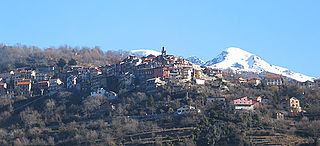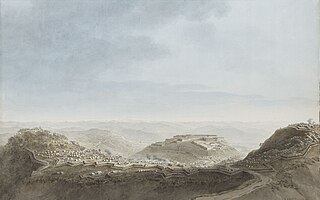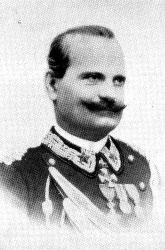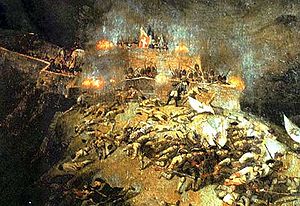
The Italian campaigns of the French Revolutionary Wars (1792–1801) were a series of conflicts fought principally in Northern Italy between the French Revolutionary Army and a Coalition of Austria, Russia, Piedmont-Sardinia, and a number of other Italian states.
The siege of Villafranca took place between 14 and 27 April 1744, during the War of the Austrian Succession. The armies of Spain and France advancing towards the Kingdom of Sardinia and attacked the entrenched positions in the Villafranca pass, defended by Anglo-Sardinian forces. The Franco-Spanish attacks were not very successful, but the defenders, due to the high losses suffered during the attacks, were forced to abandon the port of Villafranca with a large part of their forces. The small garrison that remained in the place surrendered on 27 April.
The Battle of Madonna dell'Olmo or Battle of Cuneo was fought on the outskirts of Cuneo on 30 September 1744, in the War of the Austrian Succession. The battle ended in a victory for the armies of Spain and France over the Kingdom of Sardinia but it did not advance the victors' campaign.

The Battle of Mondovì was fought on 21 April 1796 between the French army of Napoleon Bonaparte and the army of the Kingdom of Sardinia-Piedmont led by Michelangelo Alessandro Colli-Marchi. The French victory meant that they had put the Ligurian Alps behind them, while the plains of Piedmont lay before them. A week later, King Victor Amadeus III sued for peace, taking his kingdom out of the First Coalition. The defeat of their Sardinian ally wrecked the Austrian Habsburg strategy and led to the loss of northwest Italy to the First French Republic.

The Battle of Montenotte was fought on 12 April 1796, during the French Revolutionary Wars, between the French army under General Napoleon Bonaparte and an Austrian corps under Count Eugène-Guillaume Argenteau. The French won the battle, which was fought near the village of Cairo Montenotte in the Kingdom of Piedmont-Sardinia. The modern town is located in the northwestern part of Italy. On 11 April, Argenteau led 3,700 men in several assaults against a French mountaintop redoubt but failed to take it. By the morning of the 12th, Bonaparte concentrated large forces against Argenteau's now-outnumbered troops. The strongest French push came from the direction of the mountaintop redoubt, but a second force fell on the weak Austrian right flank and overwhelmed it. In its hasty retreat from the field, Argenteau's force lost heavily and was badly disorganized. This attack against the boundary between the Austrian and Sardinian armies threatened to sever the link between the two allies. This action was part of the Montenotte Campaign.
The Battle of San Pietro, also known as the Battle of Crocetta or the Battle of Parma was fought on 29 June 1734 between troops of France and Sardinia on one side, and Habsburg Austrian troops on the other, as part of the War of Polish Succession, between the village of La Crocetta and the city of Parma, then in the Duchy of Parma. Austrian troops assaulted an entrenched Franco-Sardinian position, and were ultimately repulsed, due in part to the death of their commander, Florimund Mercy, and the wounding of his second in command, Frederick of Württemberg. Both sides suffered significant casualties in the battle, which lasted for most of the day.

The Battle of Guastalla or Battle of Luzzara was fought on 19 September 1734 between Franco-Sardinian and Austrian (Habsburg) troops as part of the War of the Polish Succession.

The 26th Infantry Division "Assietta" was a infantry division of the Royal Italian Army during World War II. The Assietta was classified as a mountain infantry division, which meant that the division's artillery was moved by pack mules instead of the horse-drawn carriages of line infantry divisions. Italy's real mountain warfare divisions were the six alpine divisions manned by Alpini mountain troops. The division was named for the Battle of Assietta in 1747 and based in Asti.

Belvédère is a commune in the Vésubie valley north of Nice in the Alpes-Maritimes department in southeastern France. The village of Belvédère is located at the entrance of the Gordolasque valley on the edge of the Mercantour National Park.

In the Battle of Ceva on 16 April 1796, troops of the First French Republic under General Pierre Augereau fought against part of the army of the Kingdom of Sardinia-Piedmont led by General Giuseppe Felice, Count Vital. Augereau assaulted the strong defensive position without success. At the direction of the Sardinian army commander, Feldmarschal-Leutnant Michelangelo Colli, Vital withdrew on the 17th in order to avoid being trapped by a second French division.

The Battle of Loano saw the French Army of Italy led by General of Division (GD) Barthélemy Louis Joseph Schérer attack the Allied armies of Habsburg Austria and the Kingdom of Sardinia-Piedmont led by Feldzeugmeister (FZM) Olivier, Count of Wallis during the War of the First Coalition. The assault took the Austrians by surprise since it occurred so late in the year. Additionally, the previous Austrian commander resigned the day before the attack. While the French left flank troops pinned down the Sardinian forces opposing them, the French center broke through the Allied center, forcing the Austrians to retreat. Meanwhile, the French right flank forces steadily pressed back the Austrians on the coast. The French gained a more favorable position, but Schérer did not exploit his victory. André Masséna distinguished himself during this battle and is credited with the French victory.

The Montenotte campaign began on 10 April 1796 with an action at Voltri and ended with the Armistice of Cherasco on 28 April. In his first army command, Napoleon Bonaparte's French army separated the army of the Kingdom of Sardinia-Piedmont under Michelangelo Alessandro Colli-Marchi from the allied Habsburg army led by Johann Peter Beaulieu. The French defeated both Habsburg and Sardinian armies and forced Sardinia to quit the First Coalition. The campaign formed part of the Wars of the French Revolution. Montenotte Superiore is located at the junction of Strada Provinciale 12 and 41 in the Liguria region of northwest Italy, 15 kilometres (9 mi) northeast of Carcare municipality. However, the fighting occurred in an area from Genoa on the east to Cuneo on the west.

Michelangelo Alessandro Colli-Marchi or Michelangelo da Vigevano or Michael Colli entered the Habsburg Austrian army as a commissioned officer and became a general officer after fighting in the Seven Years' War, War of the Bavarian Succession, and Austro-Turkish War. During the War of the First Coalition, he was loaned to the Kingdom of Sardinia-Piedmont for three years. In 1796, his army was defeated by Napoleon Bonaparte in a swift campaign that knocked Sardinia-Piedmont out of the war. In early 1797, he was given command of the army of the Papal States, but his troops were defeated at Faenza.

The Second Battle of Saorgio was fought from 24 to 28 April 1794 between a French First Republic army commanded by Pierre Jadart Dumerbion and the armies of the Kingdom of Sardinia-Piedmont and the Habsburg monarchy led by Joseph Nikolaus De Vins. It was part of a successful French offensive designed to capture strategic positions in the Maritime Alps and Ligurian Alps, and on the Mediterranean coast. Tactical control of the battle was exercised by André Masséna for the French and Michelangelo Alessandro Colli-Marchi for the Coalition. Saorge is located in France, about 70 kilometres (43 mi) northeast of Nice. At the time of the battle, the town was named Saorgio and belonged to Piedmont.
The Battle of Voltri was an engagement occurring on 10 April 1796 during the French Revolutionary Wars and taking place in Voltri, a suburb of Genoa, Italy.

The First Battle of Saorgio saw a French army commanded by Gaspard Jean-Baptiste Brunet attack the armies of the Sardinia-Piedmont and Austria led by Joseph Nikolaus De Vins. The local Sardinian commander in the Maritime Alps was Charles-François Thaon, Count of Saint-André. Though the French were initially successful in this War of the First Coalition action, their main assaults against the strong defensive positions on the Massif de l'Authion and the Col de Raus failed with serious losses. Saorge is now located in France about 70 kilometres (43 mi) northeast of Nice, but in 1793 Saorgio belonged to Piedmont. In April 1794 the French seized the positions from the Austro-Sardinians in the Second Battle of Saorgio.

Vittorio Emanuele Dabormida, 2nd Count Dabormida, OSML, OCI was an Italian general and noble, mostly known for his role during the First Italo-Ethiopian War. He died in combat at Adwa, and was posthumously awarded the Gold Medal of Military Valor.

The 1st Regiment "Granatieri di Sardegna" is an active unit of the Italian Army based in Rome in Lazio. The regiment is part of the army's infantry arm's Granatieri (Grenadiers) speciality and assigned to the Mechanized Brigade "Granatieri di Sardegna". Formed in 1659 the regiment is the currently oldest active unit of the Italian Army and the most senior regiment in the Italian Army's infantry order of precedence. Together with its sister the regiment, the 2nd Regiment "Granatieri di Sardegna", the regiment is the guard regiment of Rome.

The 2nd Regiment "Granatieri di Sardegna" is an active unit of the Italian Army based in Spoleto in Umbria. The regiment is part of the army's infantry arm's Granatieri (Grenadiers) speciality and assigned to the Mechanized Brigade "Granatieri di Sardegna". Formed in 1744 the regiment is the second-most senior regiment in the Italian Army's infantry order of precedence. Together with its sister the regiment, the 1st Regiment "Granatieri di Sardegna", the regiment is the guard regiment of Rome.

The Battle of Monte Settepani saw the Coalition armies of Habsburg Austria led by Feldzeugmeister (FZM) Joseph Nikolaus de Vins and the Kingdom of Sardinia-Piedmont led by Feldmarschall-Leutnant (FML) Michelangelo Alessandro Colli-Marchi attack the Republican French Army of Italy led by General of Division (GD) François Christophe de Kellermann during the War of the First Coalition. The attack captured a few key positions though it was repulsed by most of the French defenses. After the French failed to recapture Monte Settepani, Kellermann ordered a phased withdrawal to a more defensible position. By 7 July, the French army established itself in a new position running from Borghetto Santo Spirito on the coast northwest to the crest of the Ligurian Alps. The setback compelled the French to relinquish the territory captured in the First Battle of Dego.




















